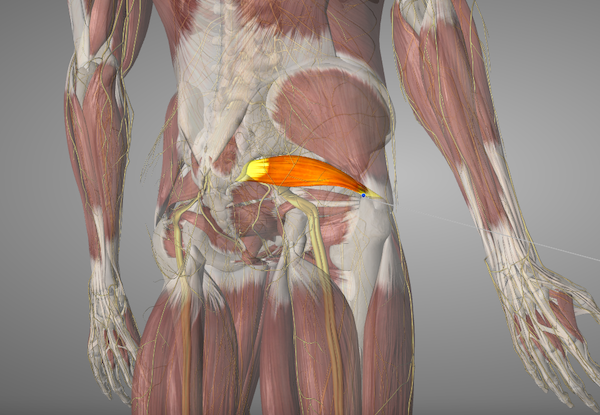Piriformis syndrome is a term used to describe pain / sensations emanating from the left/ right/ both Piriformis muscles, under the glut max muscle. The piriformis is an important deep hip stabiliser muscle and also assists in lateral hip rotation and abduction – think about the movement needed to get out of your car… The most common cause discomfort from this muscle is the sciatic nerve, that runs down right underneath it from the sacrum. In approx. 10% of the population it runs directly through the piriformis muscle. Thus a tight pirformis is thought to be a common cause of referral nerve pain.

The piriformis muscle is only one of several other muscles (gluteal and lateral hip rotators) that can give you the same symptoms as piriformis syndrome when tight. It could be a sharp acute pain, or a more dull, chronic pain. Certain activities will aggravate the pain. Pain when kicking, running, cycling or even stooping to brush teeth or getting out of a car would be a classic sign.
What causes Piriformis Syndrome?
The piriformis has to work hard to stabilise the sacrum (bone at the bottom of your spine) when getting up from a seated position or stooping over. It’s primarily an overuse injury and can be a common problem if the hamstrings or gluts are weak. In my experience it often occurs with lower back pain. It can provoke sciatica or irritate the sacroiliac joint or hip joint if the muscle is habitually contracted. Limited flexibility in the hips and lower back will also contribute to the problem. You should be able to find a position to ease the pain, however, rest will rarely resolve the problem completely.
Pain in the this area could be also be referred from other causes, such as hip bursitis or SIJ or lumber spine ‘disfunction’. Muscular imbalances in the back and trunk can cause this dysfunction. Other rare causes are stress fractures of the pelvis or hip. Avulsion fractures and ankylosing spondylitis are rare causes in the young.

Treatment for Piriformis Syndrome treatment Marlow
As a muscular overuse injury, heat is normally better than cold to provide some pain relief. Gentle hip stretches that do not reproduce the pain are advised for the lower back and legs. Examples of good stretches are here. Again due the ambiguous nature of the source of pain there is not one specific stretch I would recommend. The best option is to experiment with the stretches to see which one gives you the best relief… If symptoms have become very bad or chronic there are various treatments in the clinic that provide long-lasting relief quickly. And we would also be able to tell you the best stretch(es) to without you having to experiment!
Soft tissue massage techniques are the best way to stretch out soft tissue. Sports massage is a great way to prevent mild piriformis syndrome from getting worse. In Sports Therapy sessions we use K-Laser to stimulate healing in inflamed and irritated muscle and nerve tissue at a cellular level. Combined with physical therapy techniques and bespoke rehabilitation we get long-lasting results for you. Book a session with Mark here.
 Enter your name and email and request our free ebook: 7 Habits of Highly Effective Runners
Enter your name and email and request our free ebook: 7 Habits of Highly Effective Runners